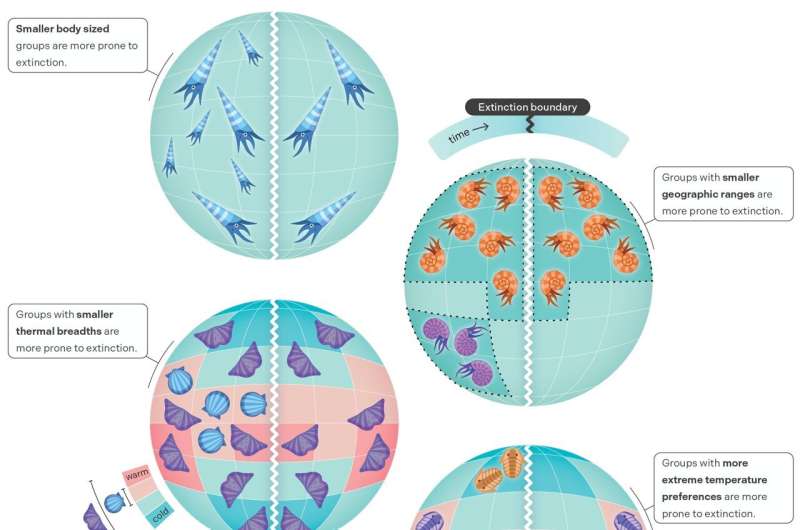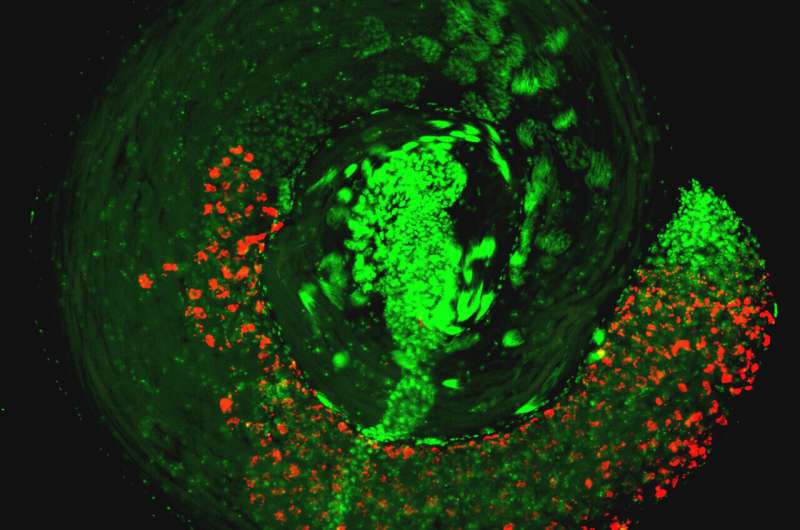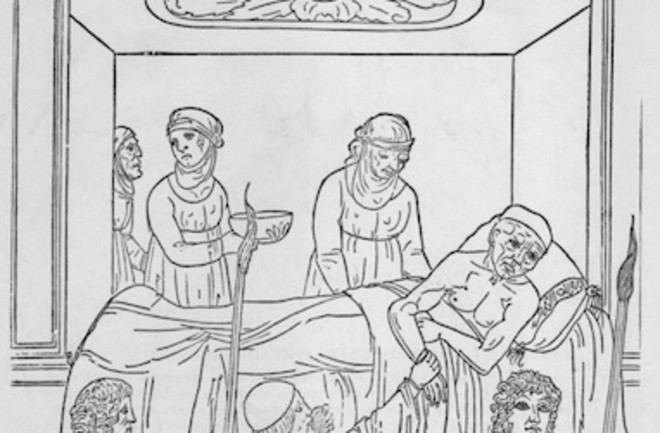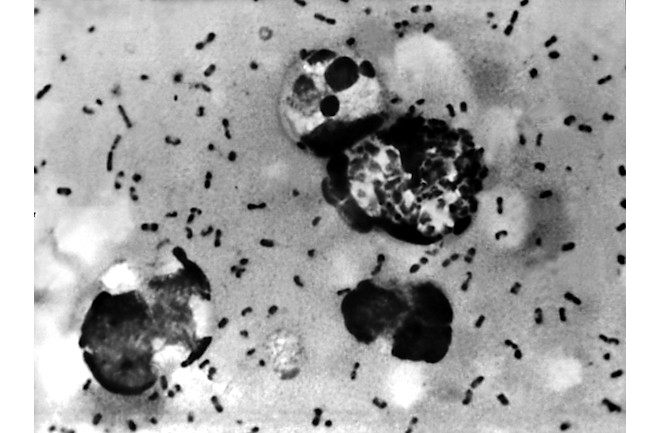PALEONTOLGY
Earth's earliest forest revealed in Somerset fossils

Scientists have discovered remnants of the Earth's oldest fossil forest on the north coast of Devon and Somerset in the U.K. The trees, which are about 390 million years old, are thought to have grown as part of an extensive forest covering the east coast of the Old Red Sandstone continent—part of Europe at that time.
This makes the Somerset forest 4 to 5 million years older than the previous record holder at Cairo, New York, in the U.S.
Discovered by researchers from Cambridge University and identified at Cardiff University, the fossils show incomplete trunks up to 2 meters long, together with small branches, of a pioneering type of tree called cladoxylopsids.
Cladoxylopsids dominated terrestrial ecosystems for a period of about 5 million years before the advent of more modern woody trees about 385 million years ago, according to the team.
Their findings, presented in the Journal of the Geological Society, throw new light on the evolution of trees and the transformative role they played in shaping the world we live in today.
Dr. Christopher Berry, a Senior Lecturer at Cardiff University's School of Earth and Environmental Sciences who identified the fossils, said, "These Calamophyton trees are the oldest fossil trees ever found in Britain and represent an as yet missing part of our vegetational history.
"The record of fossil forests, where tree bases are preserved where they were living, so far dates back to those discovered in New York State, at Cairo and Gilboa at about 385 million years.
"Although the area of rock exposure is limited and dangerous to access, our new discovery is the oldest clear example of such a geological phenomenon known to date and it speaks directly to the ecology of the oldest forests 390 million years ago."
At first glance, the Calamophyton resemble palm trees, but were unrelated to the kinds of trees that populate Earth today.
Rather than solid wood, their trunks were hollow in the center with a ring of woody supporting strands around the outside. Instead of leaves their branches were covered in hundreds of twig-like structures.
The trees were also much shorter than their descendants, standing between 2 and 4 meters tall and as they grew, they shed their lower branches, dropping lots of vegetation litter, which supported invertebrates on the forest floor.
The team also found evidence for bases of the trees, and their fallen trunks, demonstrating for the first time the environmental context and spacing of the trees while they were living.
Dr. Berry added, "The shape and forms of these structures taken together strongly suggest that these the Calamophyton were standing alongside a raised bank beside a small river channel.
"I was able to identify the tree trunks based on 30 years studying these types of fossils and particularly having worked on the best and most complete specimens of Calamophyton from Belgium and Germany where they are well known but relatively rare.
"Nevertheless, it was a bit of a shock. Having traveled the world in search of the earliest forests, it is amazing to know that you can see the localities from here on the South Wales coast."
The team says the North Devon and Somerset site was likely located much nearer Belgium and Germany in the Devonian period, before it was relocated along a huge geological fault during the Carboniferous period at a time of crustal compression and faulting when Africa collided with Europe.
The study's first author Professor Neil Davies of Cambridge University's Department of Earth Sciences said, "The Devonian period fundamentally changed life on Earth. It also changed how water and land interacted with each other, since trees and other plants helped stabilize sediment through their root systems, but little is known about the very earliest forests.
"The evidence contained in these fossils preserves a key stage in Earth's development, when rivers started to operate in a fundamentally different way than they had before, becoming the great erosive force they are today.
"People sometimes think that British rocks have been looked at enough, but this shows that revisiting them can yield important new discoveries."
More information: Neil S. Davies et al, Earth's earliest forest: fossilized trees and vegetation-induced sedimentary structures from the Middle Devonian (Eifelian) Hangman Sandstone Formation, Somerset and Devon, SW England, Journal of the Geological Society (2024). DOI: 10.1144/jgs2023-204. www.lyellcollection.org/doi/ab … /10.1144/jgs2023-204
Journal information: Journal of the Geological Society
Provided by Cardiff University
Scientists uncover world's oldest forest
New study reveals which animals are most vulnerable to extinction due to climate change

In a new study, researchers have used the fossil record to better understand what factors make animals more vulnerable to extinction from climate change. The results could help to identify species most at risk today from human-driven climate change. The findings have been published in the journal Science.
Past climate change (often caused by natural changes in greenhouse gases due to volcanic activity) has been responsible for countless species' extinctions during the history of life on Earth. But, to date, it has not been clear what factors cause species to be more or less resilient to such change, and how the magnitude of climate change affects extinction risk.
Led by researchers at the University of Oxford, this new study sought to answer this question by analyzing the fossil record for marine invertebrates (such as sea urchins, snails, and shellfish) over the past 485 million years. Marine invertebrates have a rich and well-studied fossil record, making it possible to identify when, and potentially why, species become extinct.
Using over 290,000 fossil records covering more than 9,200 genera, the researchers collated a dataset of key traits that may affect resilience to extinction, including traits not studied in depth previously, such as preferred temperature. This trait information was integrated with climate simulation data to develop a model to understand which factors were most important in determining the risk of extinction during climate change.
Key findings:
- The authors found that species exposed to greater climate change were more likely to become extinct. In particular, species that experienced temperature changes of 7°C or more across geological stages were significantly more vulnerable to extinction.
- The authors also found that species occupying climatic extremes (for instance in polar regions) were disproportionately vulnerable to extinction, and animals that could only live in a narrow range of temperatures (especially ranges less than 15°C) were significantly more likely to become extinct.
- However, geographic range size was the strongest predictor of extinction risk. Species with larger geographic ranges were significantly less likely to go extinct. Body size was also important, with smaller-bodied species more likely to become extinct.
- All of the traits studied had a cumulative impact on extinction risk. For instance, species with both small geographic ranges and narrow thermal ranges were even more susceptible to extinction than species that had only one of these traits.
Cooper Malanoski (Department of Earth Sciences, University of Oxford), first author of the study, said, "Our study revealed that geographic range was the strongest predictor of extinction risk for marine invertebrates, but that the magnitude of climate change is also an important predictor of extinction, which has implications for biodiversity today in the face of climate change."
With current human-driven climate change already pushing many species up to and beyond the brink of extinction, these results could help identify the animals that are most at risk, and inform strategies to protect them.
Lead author Professor Erin Saupe (Department of Earth Sciences, University of Oxford) said, "The evidence from the geological past suggests that global biodiversity faces a harrowing future, given projected climate change estimates.
"In particular, our model suggests that species with restricted thermal ranges of less than 15°C, living in the poles or tropics, are likely to be at the greatest risk of extinction. However, if the localized climate change is large enough, it could lead to significant extinction globally, potentially pushing us closer to a sixth mass extinction."

According to the research team, future work should explore how climate change interacts with other potential drivers of extinction, such as ocean acidification and anoxia (where seawater becomes depleted of oxygen).
The study also involved researchers from the School of Geographical Sciences, University of Bristol. Professor Dan Lunt, from the University of Bristol, said, "This study shows that over the course of Earth's history, the extinction risk of marine life has been inextricably linked to climate change. This should act as a stark warning to humanity as we recklessly continue to cause climate change ourselves through burning fossil fuels."
More information: Cooper M. Malanoski et al, Climate change is an important predictor of extinction risk on macroevolutionary timescales, Science (2024). DOI: 10.1126/science.adj5763. www.science.org/doi/10.1126/science.adj5763
Journal information: Science
Provided by University of Oxford Mathematician creates mass extinction model regarding climate change and adaptation





